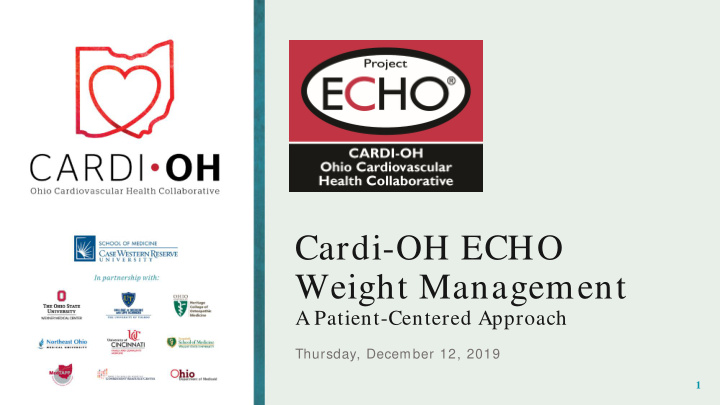



Cardi-OH ECHO Weight Management A Patient-Centered Approach Thursday, December 12, 2019 1
Disclosure Statements The following planners, speakers, moderators, and/ or panelists of the CME activity have financial relationships with commercial interests to disclose: • Adam T. Perzynski, PhD reports being co-founder of Global Health Metrics LLC, a Cleveland- based software company and royalty agreements for forthcoming books with Springer publishing and Taylor Francis publishing. • Siran M. Koroukian, PhD received funds for her role as a site PI on a subcontract with the Cleveland Clinic. • Christopher A. Taylor, PhD, RDN, LD, FAND reports grant funding and travel support for his role as a consultant, researcher, and presenter for Abbott Nutrition, and is also a member of the Scientific Advisory Council of Viocare, Inc. • These financial relationships are outside the presented work. All other planners, speakers, moderators, and/ or panelists of the CME activity have no financial relationships with commercial interests to disclose. 2
The Future & Wrap-up Goutham Rao, MD Chief Clinician Experience and Well-Being Officer, University Hospitals Health System Jack H. Medalie Endowed Professor and Chairman Department of Family Medicine and Community Health Division Chief, Family Medicine, Rainbow Babies and Children’s Hospital Case Western Reserve University School of Medicine & University Hospitals of Cleveland 3
Objectives After attending this brief didactic session, you should be able to accomplish the following: 1) List and describe a minimum of 2 emerging pharmacotherapies for obesity care. 2) List and describe a minimum of 3 endoscopic balloon treatments for obesity care. 3) Summarize changes in the relative use of bariatric surgery procedures over the past decade. 6
5
Deb Cohen, PhD 6
7
Pharmacotherapy - Semaglutide 8
Other emerging GLP-1 agonists • Codatutide 9
10
The rise of sleeve gastrectomy in bariatric surgery • Changes in types of operations in adults: • 2008 – RYGB 75.4% ; AGB 23.8% ; Sleeve gastrectomy 0.9% • 2012 – RYGB 59.6% ; AGB 4.1% ; Sleeve gastrectomy 36.3% 11
The beginnings… • Garren-Edwards Gastric Bubble (GEGB) – approved in December 1984 • Placed endoscopically in the stomach • Filled with 200-220mL of air • Free floating • Removed at 4 months • 7-10kg weight loss; gradually regained • Complications: spontaneous deflation; ulcers • Withdrawn completely in 1992 • No FDA approved intra-gastric balloons until 2015 12
Tarpon Springs Workshop - 1987 • “Obesity and the Gastric Balloon: A Comprehensive Workshop” • 1) construction with high-quality silicone elastomer • 2) saline-fluid filled • 3) spherical with a smooth surface • 4) radiopaque marker • 5) volume to be adjustable between 400 – 500mL • 6) BMI ≥ 30kg/m 2; No prior gastric surgery 13
Bioenterics Intragastric Balloon (Orbera) • 1991 • FDA Approval 2015 • Endoscopic placement and removal (6 months) • Effectiveness: • ASGE Meta-Analysis (2015): • At 12 months post-placement • 11.3% absolute weight loss; • 25.4% EWL • At 5 years, average BMI loss is 2.5kg/ m2 • 23% of patients maintain > 20% EWL at 5 years • Early removal, 7.5% ; migration 1.4% ; gastrointestinal perforation, 0.1% . • Genco et al – European multi-center study: • 55.6% EWL at 6 months; 29.1% at 3 years Hypertension prevalence ↓ 29% to 16% • Diabetes prevalence ↓ 15% to 10% • Hyperlipidemia ↓ 32% to 21% • • FDA revised labeling 14
ReShape Integrated Dual Balloon System • Approved in 2015 • Endoscopic placement and removal • Saline-filled (750 – 900mL) • REDUCE sham controlled trial: • AT 6 months, EWL was 25.1% vs 11.3% after sham endoscopy • Systolic BP fell by 8.3mmHg; HbA1C% fell by 0.2% ; LDL fell by 4.1mg/ dL • 9% of devices removed for intolerance 15
Obalon • Approved in 2016 • 3 balloons, placed one month apart. • Swallowed placement; endoscopic removal • RCT Results: EWL of 24.1% • More recent data (cohort) • 1300+ dataset • Average weight loss of 21.7lbs; 9.9% reduction in body weight • Top quartile lost 39lbs on average (16.8% of body weight) 16
Mechanism of Action Primary: Delayed gastric emptying 17
18
...The bottom line • Policy changes to promote a healthier built environment are our only long-term hope. • Consider obesity a chronic, relapsing condition, for which a number of treatments are available. 19
Thank you! Questions/ Discussion 20
Reminders • A Post-Clinic Survey will be emailed to you. Please complete this survey as soon as possible. • The MetroHealth System is accredited by the Ohio State Medical Association to provide continuing medical education for physicians. • The MetroHealth System designates this educational activity for a maximum of 1 AMA PRA Category 1 Credit(s)TM. Physicians should only claim credit commensurate with the extent of their participation in the activity. 21
Final ECHO Evaluations • You will receive two surveys at the completion of today’s clinic: 1. Week 12 Post-Clinic Survey (please complete by Friday, 12/ 13/ 19 at 5: 00 PM) 2. Exit Survey (please complete this series evaluation by Friday, 1/ 10/ 20 at 5: 00 PM) • To those who wish to claim CME credits: • You will receive a survey from the CME office through MyEvaluations.com on Tuesday, 12/ 17/ 19. You will need to register with MyEvaluations.com to begin this process. 22
Watch Previous ECHO Clinics Register with Cardi-OH and watch all ECHO Weight Management Clinics https: / / www.cardi-oh.org/ user/ register https: / / www.cardi-oh.org/ echo/ weight-management-fall-2019 23
Registration is Open! Spring 2020 teleECHO Clinic: Reducing the Burden of Hypertension Thursdays, 8-9 AM, January 16 – April 2, 2020 https: / / www.cardi-oh.org/ echo/ hypertension-spring-2020 24
Recommend
More recommend